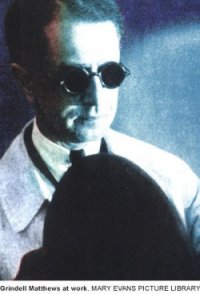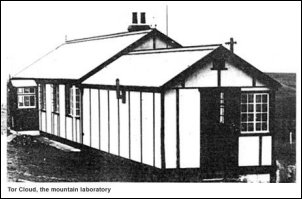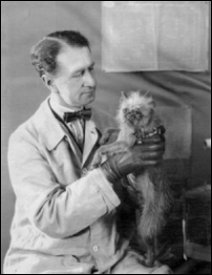DEATH RAY MATTHEWSHenry Grindell Matthews (1880–1941)
The Mad Scientist of MynyddygwairIntroduction
'Mad' Scientist Henry Grindell Matthews, looking suitably sinister One of the advantages of living in a town like Ammanford is that we are surrounded by mountains. To the east is the lovely Black Mountain, the western foothills to the Brecon Beacons National Park, while to the south lies the Betws Mountain, with the Amman Valley neatly bisecting the two and marking their boundaries. Do not, by the way, confuse our Black Mountain with the Black Mountains, which confusingly make up the eastern foothills of the same Brecon Beacons. Even more confusingly, both mountain ranges contain a hill called the Sugar Loaf.
Although these lonely hills have their own histories, in this website we have rarely wandered from the paved streets of Ammanford town and onto their lovely moorland vistas. The Black Mountain is a source of legend as well as history, the Lady of the Lake and the Arthurian hunting of the Twrch Trwyth (Wild Boar) being among them. But the Betws Mountain has one story that, while it belongs fully in the realms of history (and recent history, at that), is so strange that in many ways it is stranger than all the fairies, wizards and Celtic heroes of our local legends.
More for human convenience than anything else, the Betws Mountain is divided into ranges on an otherwise continuous stretch of upland which have been given local names. Mynnydd y Gwair (literally, the mountain of hay) is one such stretch of hillside on which was played out the mysterious pre-war goings-on which Ammanford genealogist Ellyn Harries recounted in the local history magazine Carmarthenshire Life. Here, with Ms Harries's permission, is the story of 'Death Ray' Matthews.
Death Ray Mattews
Tor Cloud bungalow, the mysterious laboratory on the Betws Mountain above Ammanford Laser beams, mobile phones, radio waves, submarine detection, star wars technology, electronic burglar alarms, automatic street lighting, aerial minefields, cloud projection and talking pictures – all were dreamt of on the fringes of Carmarthenshire more than seventy years ago!
....High on a misty mountain on top of Mynyddygwair is a road once marched along by Roman legionnaires, where Drovers passed a scotch pine (now the name of a pub) and turned south on the long way to distant markets, and where now residents of Ammanford and Betws take a scenic shortcut to Swansea. There still stands a long white bungalow by the name of Tor Cloud (this is probably a corruption of the Welsh tor clawdd, meaning a break, or interruption, in a hedge). For endless seasons, only winds swept along the barren moorland, where occasional drifting birds and wandering sheep visited the lonely site.
....The tranquillity of the mountain top was shattered one morning in 1934 by the roar of a Puss Moth aircraft, circling on a secret mission. Aboard was a scientist by the name of Henry Grindell Matthews searching for "an untouched background of space, offering secrecy and privacy". The site he chose offered him the seclusion he so desperately sought. Within a matter of days, his neighbours began to gather and stare with curiosity where work was in progress on a laboratory and living quarters. Gossip soon swept down the hillsides towards Ammanford and Betws about the hermit and why he had chosen to live in such isolation. But once a strong fifteen-foot-high electrified fence complete with steel gates was put around the compound, crowds actually gathered with excitement and great speculation. Why had he taken such elaborate, unusual and very costly precautions to prevent anyone from getting even a glimpse through the strands of barbed wire encircling the site?
....When inquisitive villagers discovered Mr. Grindell Matthews was a scientist, legends began to be woven about the mystery man conducting top-secret experiments. Rumours rumbled down the vales and up the valleys. Letters to the local newspapers and reports to the police spoke of a ray that he was perfecting to protect the residents of Carmarthenshire and even adjoining counties from enemy invasion. Others thought he could create and even stop earthquakes while others whispered that dangerous germs carrying virulent diseases were being grown on the site. In the local pubs at night, stories were spun of a rocket that would be launched to fly to the moon or even other planets. Even better, especially in Wales, a machine would be unveiled that could control the weather!
....Some became quite frightened and fuel was added to the fires of their imaginations when a police officer was sent by the Chief Constable of Carmarthenshire to inspect Tor Cloud and interrogate its owner because a young man had been taken ill very suddenly while out of doors. His father had harboured the strong suspicion that the cause was connected with the experimental work at the laboratory– even though he lived over forty miles away! What on earth was going on up there?
....The world's press laid siege to the site clamouring for news about the nature of his experiments. Later, amazing headlines with intriguing articles published in newspapers ranging from Calcutta to Canada, South America to China, all across the United States and throughout Europe, would be carefully cut out and placed in enormously large and thick green leather bound volumes which now can be discovered at the West Glamorgan Archives in Swansea. Henry Grindell Matthews' name was engraved in gold on each cover documenting an incredible career and they are fascinating reading.
'Death Ray' Matthews and friend, hopefully not about to be subjected to one of his experiments ....Born in 1880, Grindell Matthews was educated at Bristol Merchant Venturer's College and at nineteen he volunteered to fight in the Boer War. Wounded twice and decorated, he then trained as a research scientist specialising in electricity. He was especially intrigued by the possibilities of radiotelephony and as early as 1911, from Ely Racecourse in Cardiff, he succeeded in conversing with a pilot flying an airplane two miles away.
....Following the onset of World War One, his experiments in developing a robot boat controlled by a light beam using a new light sensitive material, selenium, brought him quickly to the attention of the British Government. He proved his claims in trials at Portsmouth using a larger steamship, which was controlled by a searchlight more than five miles away. The Government provided a first instalment of £25,000 so he could further develop this device and produce an aerial torpedo to be used against the Zeppelin.
....In 1924, Grindell Matthews really set the world abuzz when newspapers got hold of the rumour that he had invented an invisible ray which could, "stop a motor working, kill plant life, destroy vermin, explode gunpowder, fire cartridges and light lamps." Inevitably, the invention and its inventor were dubbed "Death Ray" and the man himself became the centre of fantastic public interest. The public wanted to believe that he had the ability to control armies, make aircraft fall from the sky and the power to stop war. Later, many of his Welsh neighbours would tell of their lorries or cars stalling on their way to or from Swansea – or even their tractors grinding to a halt in their fields.
....On Christmas Eve 1930, late shoppers in the Hampstead Heath were startled to see a beam of light shoot up 6,000 feet to the cloud base. It then took on the form of a rather voluptuous angel with outstretched wings gliding across the sky. Traffic stopped and crowds gathered to gaze in awe as the angel vanished only to be replaced by the words "A Happy Christmas". Grindell Matthews had much more than a Christmas card in mind, "The advantages of the machine in war time for conveying coded messages to airmen are obvious but it also has many possibilities for electioneering purposes, advertising and announcing the news."
....Five years later, he was giving newspaper interviews 1,500 feet up at Tor Cloud and reporters told their readers how they "exclusively" had penetrated the ring of armed guards, barbed wire fences and secret-eye burglar alarms around the hide-out, to learn how the inventor of the death ray now planned to defend London from foreign attack.
....This was to be accomplished by firing rockets to a height of 30,000 feet, where, at that altitude, aerial torpedoes would release a brood of bombs suspended from parachutes by 500 feet of wire. Two years later, in addition to his air defence scheme, Grindell Matthews was perfecting an apparatus that would detect submarines 30 miles away. By 1939, he was seeking new and more vital propellants for his rockets.
....Grindell Matthews said his destructive rays could operate over a distance of four to eight miles. "Ships, like land, are in continual contact with the earth, but what I can do is to put the ships out of action by the destruction of vital parts of the machinery and also by putting the crews temporarily out of action through shock. Airplanes could be completely destroyed. "My Ray of Hope is capable of killing a man or an army, and of stopping a motor or an aeroplane. Alternatively, it can be regulated so that the human object at whom it is directed is benumbed and rendered unconscious; in this way a body of men could easily and painlessly be taken prisoners. It is far more effective than a machine gun, as it kills a man instantaneously, painlessly and cleanly."
....In his rush against the threat of war, his laboratory assistants became unintentional victims of the ray. When accidentally crossing its path during tests they were either knocked unconscious by violent electrical shocks or they received intense burns.
....Popular Science Magazine, back in the twenties, had several articles about Grindell Matthews and his new weapons that could change the face of warfare. It stated that by directing a beam in the direction of a gasoline engine, he could stop it dead. Enemy airplanes could be forced out of the sky without a shot. This gun could ignite gunpowder, light an electric light from a distance and, even kill a mouse! The Air Ministry offered him cash for further experimentation, but Grindell Matthews refused. He moved to America for a while, claiming that his experiments with his death ray had cost him his sight in one eye.
....Grindell Matthews found his way to Hollywood and his probing mind went off in yet another direction – how to make films "speak". In 1921, the inventor made a "talkie" of Sir Ernest Shackleton delivering his farewell speech before setting off to Antarctica. "I have in my laboratories numerous inventions capable of commercial use. My tone-wheel can reproduce any and every musical work with the skill of an orchestra and the tonal quality of a grand organ. I also have an invention for combining the sounds of a drama with its pictorial reproduction so that films can be absolutely and flawlessly accompanied by vocal action. In fact, I venture to predict that in ten years time the present silent film will be as dead as Tutankhamen." He became a consultant to Warner Brothers and many of his inventions featured in Flash Gordon movies!
....The inventor's personal life was shrouded in as much mystery as his work. In January 1938, he became the fifth husband of Madame Ganna Walska, a wealthy Polish opera singer of whom one unkind critic wrote, "Better seen than heard." She was referred to by the newspapers of the day as the "£25,000,000 bride" because of the fortunes of her four previous husbands. Grindell Matthews also married a very wealthy American socialite, so it seems that not all of his time was spent in laboratories!
....Often labelled a "mad scientist" and given the nickname of "Death Ray Matthews", he pressed ahead with his experiments in spite of a heart condition. In the autumn of 1941, he collapsed and died whilst perfecting his system of defence against air attacks. Within hours of his friends and relatives witnessing his ashes being scattered to the winds on the mountainside of Mynyddygwair, his laboratory was stripped of its secrets by Government Officials and agents from Military Intelligence.
....Uncannily, he wrote on May 3, 1924 an article in John Bull entitled My Ray of Death: "In these later days, when existence is but a stone's throw from the torments and tortures of war, the scientific minds of the world are grappling with the potentialities of a war waged around the cauldrons of the chemists' laboratories … If the world wants no more weapons of scientific destruction, then the world must do away with war … and science can save our civilisation."Ellyn Harries
Sources of Additional Reading about Death Ray Matthews:
– West Glamorgan Archives – The Henry Grindell Matthews Collection.
– "Mystery Man" by Arthur Henderson – unpublished novel also in the Archives.
– "Death Ray Man" by H. G. Barwell published by Hutchinson Press 1941.An article summarising the life and achievements of our hero can be found on the on-line encyclopedia website Wikipedia. Or type Death Ray Matthews into any search engine.



